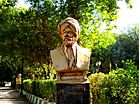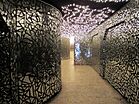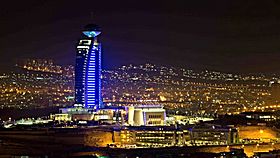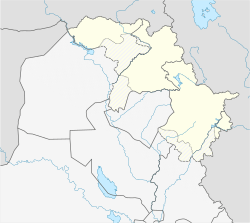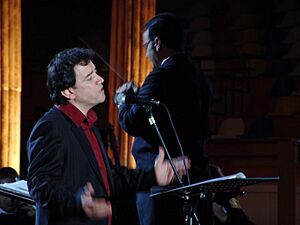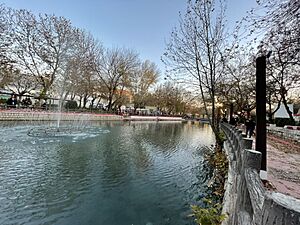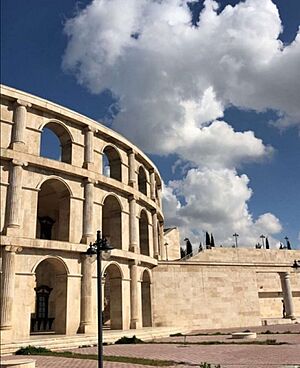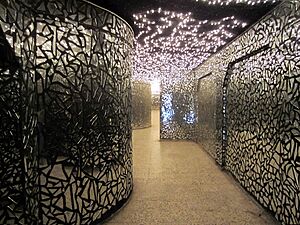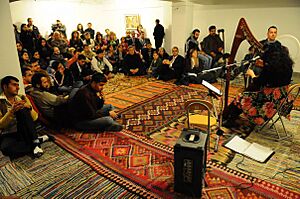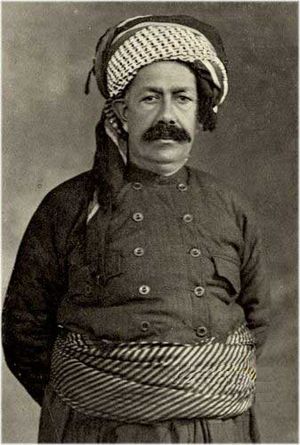Sulaymaniyah facts for kids
Quick facts for kids
Sulaymaniyah
سلێمانی
Silêmanî |
|
|---|---|
|
Top-bottom, R-L:
View over Suleymaniyah Roman amphitheater • Sharafkhan Bidlisi statue Amna Suraka Museum • Sulaymaniyah Museum Suleymaniyah at night |
|
| Country | |
| Region | Kurdistan Region |
| Governorate | Sulaymaniyah Governorate |
| Elevation | 882 m (2,895 ft) |
| Population | |
| • Estimate
(2018)
|
676,492 |
| Time zone | UTC+3 (AST) |
| Website | https://slemani.gov.krd/ |
Sulaymaniyah or Slemani (Kurdish: سلێمانی, romanized: Silêmanî; Arabic: السليمانية, romanized: as-Sulaymāniyyah), is a city in the east of the Kurdistan Region of Iraq and is the capital of the Sulaymaniyah Governorate. It is surrounded by the Azmar (Ezmer), Goizha (Goyje) and Qaiwan (Qeywan) Mountains in the northeast, Baranan Mountain in the south and the Tasluja Hills in the west. The city has a semi-arid climate with very hot dry summers and cold wet winters.
The modern city of Slemani was founded in 1784 by the Ottoman-Kurdish prince Ibrahim Pasha Baban, who named it after his father Sulaiman Pasha. Slemani was the capital of the historic principality of Baban from 1784 to 1850.
Contents
History

The region of Slemani was known as Zamwa prior to the foundation of the modern city in 1784. The capital of the Kurdish Baban principality (1649–1850), before Slemani, was a territory named "Qelaçiwalan". At the time of the Babani's rule there were major conflicts between the Safavid dynasty and the Ottoman Empire. Qelaçiwalan became a battleground for the two rivals.
In 1783, Ibrahim Baban became ruler of the emirate and began the reconstruction of a city which once constructed by Ottoman Sultan Sulaiman (the name of Sulaimaniyah came from his name) new city which would become its capital. In 1784 he finished erecting a number of palaces for trade called Qeyserîs and bazaars, which were also used as baths, and began inviting people from the surrounding villages and emirates to move to the newly established city. Soon Melkendî, which was originally intended to be the city itself, instead became one of its quarters. The new city of Slemani was named after Sulaiman Baba, who was the first Baban prince to gain control of the province of Şarezûr. Sulaiman Baban invaded the neighboring Kurdish vassaldom of Ardalan, defeating their forces in 1694. Ottoman Sultan Mustafa II assigned him the district of Baban.
According to Jewish tradition, Sulaiman baban emphasized the importance of a town having Jewish residents for its completeness. A mission was then sent to Qaradagh, a town with a thriving Jewish community, and surrounding villages. The Jews of Qaradagh responded by sending the first group of Jewish inhabitants to Sulaimaniya.
In the early 1800s refugees from Ardalan moved to Slemani, including Mastura Ardalan, the widow of Xosraw Xanî Erdalan, the ruler of the kingdom. Erdalan wrote an account of Kurdish history in Persian and was buried in Slemani when he died in 1848.
From 1922 to 1924, Slemani was the capital of the Kingdom of Kurdistan, a short-lived unrecognized state declared by Iraqi Kurds following the collapse of the Ottoman Empire.
Demographics
In 1820, only 36 years after the creation of the city, a British man named Rech visited the city and estimated that its population was more than ten thousand, containing 2,144 families of which 2,000 were Muslim, 130 Jewish, and 14 Christian.
Ottoman documents from 1907 suggest that there were 8,702 Muslim and 360 non-Muslim residents living in the city at that time. The Peshkawtin newspaper which was distributed in Slemani in 1920 estimated its population to be around ten thousand.
The early 1920s Iraqi Revolt against the British rule of the Mandate for Mesopotamia led by Shaikh Mahmud triggered a wave of Jewish emigration from Sulaymaniyah.
According to Iraqi government documents, by 1947 the number of residents had increased to 23,475. In the same year, records documented the existence of three hundred Jewish families, comprising a total of 1,517 individuals. Notably, nearly the entire Jewish community, except one family, made aliyah to the emerging State of Israel in 1951–52.
By 1998, the local population was estimated at 548,747, which grew in 2015 to an estimated 656,100.
The American University of Iraq, Sulaimani estimated the number of inhabitants in 2016 at 800,000.
Geography and climate
The city is located in northern Iraq and Southern Kurdistan. Of the main population centres in the country, it is characterized by its cooler summer temperatures and its rainier winters. Average temperatures range from 0 to 39 °C (32–102 °F). In the winters, there can be a significant amount of snow. Snow falls every year or two.
The Köppen-Geiger climate classification system classifies its climate as hot-summer Mediterranean climate (Csa).
| Climate data for Sulaymaniyah (1991-2021) | |||||||||||||
|---|---|---|---|---|---|---|---|---|---|---|---|---|---|
| Month | Jan | Feb | Mar | Apr | May | Jun | Jul | Aug | Sep | Oct | Nov | Dec | Year |
| Mean daily maximum °C (°F) | 8.6 (47.5) |
10.7 (51.3) |
15.5 (59.9) |
20.8 (69.4) |
27.3 (81.1) |
34.3 (93.7) |
38.5 (101.3) |
38.7 (101.7) |
33.7 (92.7) |
26.4 (79.5) |
16.5 (61.7) |
11.0 (51.8) |
23.5 (74.3) |
| Daily mean °C (°F) | 3.4 (38.1) |
5.3 (41.5) |
9.8 (49.6) |
14.8 (58.6) |
20.8 (69.4) |
27.3 (81.1) |
31.4 (88.5) |
31.4 (88.5) |
26.5 (79.7) |
19.6 (67.3) |
10.4 (50.7) |
5.4 (41.7) |
17.2 (62.9) |
| Mean daily minimum °C (°F) | −1.5 (29.3) |
−0.5 (31.1) |
3.1 (37.6) |
7.4 (45.3) |
12.4 (54.3) |
17.9 (64.2) |
22.0 (71.6) |
22.0 (71.6) |
17.5 (63.5) |
12.3 (54.1) |
4.4 (39.9) |
0.3 (32.5) |
9.8 (49.6) |
| Average precipitation mm (inches) | 136 (5.4) |
133 (5.2) |
122 (4.8) |
91 (3.6) |
30 (1.2) |
1 (0.0) |
0 (0) |
0 (0) |
1 (0.0) |
40 (1.6) |
81 (3.2) |
112 (4.4) |
747 (29.4) |
| Average rainy days | 10 | 10 | 13 | 8 | 4 | 1 | 1 | 0 | 0 | 4 | 5 | 11 | 67 |
| Average snowy days | 4 | 2 | 1 | 0 | 0 | 0 | 0 | 0 | 0 | 0 | 0 | 0 | 7 |
| Average relative humidity (%) | 70 | 69 | 61 | 56 | 41 | 24 | 20 | 18 | 22 | 33 | 56 | 67 | 45 |
| Average dew point °C (°F) | −1 (30) |
0 (32) |
2 (36) |
4 (39) |
5 (41) |
3 (37) |
4 (39) |
4 (39) |
2 (36) |
2 (36) |
1 (34) |
2 (36) |
2 (36) |
| Mean monthly sunshine hours | 164.3 | 175.2 | 213.9 | 237 | 316.2 | 408 | 418.5 | 396.8 | 351 | 272.8 | 207 | 167.4 | 3,328.1 |
| Mean daily sunshine hours | 5.3 | 6.2 | 6.9 | 7.9 | 10.2 | 13.6 | 13.5 | 12.8 | 11.7 | 8.8 | 6.9 | 5.4 | 9.1 |
| Mean daily daylight hours | 10.5 | 11.4 | 12.4 | 13.6 | 14.5 | 15.0 | 14.8 | 13.9 | 12.8 | 11.7 | 10.7 | 10.3 | 12.6 |
| Source: Climate-Data.org (altitude: 849m), Weatherbase(daylight-dew point-rain and snow days), Weather2visit(sun) | |||||||||||||
Education
The University of Slemani was opened in 1968 with instruction in Kurdish, Arabic, and English. It has faculties in engineering, agriculture, the arts, science, and medicine. It is the largest university in the Kurdistan Region. A second university, Sulaimani Polytechnic University was established in 2012, also teaching in Kurdish, English and Arabic.
In 2007 The American University of Iraq – Sulaimani, (AUI-S) was a new addition to the American universities in the Middle East, graduating its fifth class in 2016. Instruction at this private, not-for-profit liberal arts university is in English only, featuring a US-accredited program in English as a Second Language (ESL). There are a number of other private universities.
Culture
Two independent newspapers Hawlati and Awena and two independent political magazines Lvin and Shock, are published and distributed in Slemani city. Since 2016, there exists an International Film Festival in the city which is organized by the College of Fine Arts of the University of Sulaymanya.
Slemani is the only city in South Kurdistan that regularly celebrates World Music Day or Fête de la Musique. In one trip to the city, a journalist working for the BBC wrote about Slemani's distinct culture:"Culture is hugely important to the Kurdish people, especially in Slemani, but there is a strong pull to the west—modernisation and consumerism—driven perhaps by the satellite televisions they have had access to since they started running their own affairs...And at the university, students mill around the campus, chattering with each other and doing some last-minute cramming for their exams. The war only stopped lectures for a few weeks. There are probably more women than men and they are happy to air their views to anyone who asks."
Slemani was the home of poets such as Nalî, Mahwi, and Piramerd.
Economy

Since 2003, Slemani has experienced a growing local economy. Its economy today relies on tourism, agriculture and a number of small factories, most of which are involved in the building trade.
In 2004 the Comprehensive Food Security and Vulnerability Analysis in Iraq released an in-depth survey of the Slemani Governorate in which they surveyed each city. In this survey, one can see the economic boom of 2003 mentioned earlier.
Tourism
The city was visited by more than 60,000 tourists in 2009. Slemani attracted more than 15,000 Iranian tourists in the first quarter of 2010, many drawn by the fact it is not subject to strict laws faced at home. Newroz 2010 drew an exodus of Iranian tourists choosing to celebrate the event in the region.
Museums
- Sulaimani Museum: It is the second biggest museum after the national museum in Baghdad. It is home to many Mesopotamian, Kurdish and ancient Persian artifacts dating back to 1792–1750 BC.
- Amna Suraka museum
- Museum of Modern Art (Mozehanai Hunari Howchah)
- Sulaimani Archeological Museum
Notable people
- Khâlid-i Baghdâdî (1779–1827), sufist and Islamic thinker
- Salim (1800–1866), poet
- Nalî (1800–1873), poet
- Saeb (1854–1910), poet
- Mahwi (1830–1906), poet
- Said Pasha Kurd, (1834–1907), Ottoman statesman
- Şerif Pasha, (1865–1951), Ottoman diplomat, ambassador and statesman
- Mustafa Yamulki (1866–1936), Minister of Education in the Kingdom of Kurdistan
- Haji Mala Saeed Kirkukli Zada (1866–1937), Minister of Justice in the Kingdom of Kurdistan
- Piramerd Tawfeq Mahmoud Hamza, (1867–1950), poet and journalist
- Mevlanzade Rifat Bey, (1869 - 1930), journalist and politician
- Muhamed Amin Zaki (1880–1948), historian, statesman and politician
- Taufiq Wahby (1891–1984), linguist, politician and poet
- Sheikh Nuri Sheikh Salih Sheikh Ghani Barzinji (1896–1958), journalist and poet
- Ahmad Mukhtar Baban (1900–1976), prime Minister of Iraq 1958
- Abdulla Goran (1904–1962), founder of modern Kurdish poetry
- Ibrahim Ahmad (1914–2000), novelist, poet and translator
- Jamal Nebez (1933-2018), Kurdish linguist, mathematician, politician, author, translator and writer.
- Nawshirwan Mustafa (1944–2017), politician, historian and media proprietor
- Barham Salih, 8th president of Iraq
- Ahmad Hardi (1922–2006), poet
- Sherko Bekas (1940–2013), contemporary poet
- Bachtyar Ali (born 1960), novelist
- Muhamad Salih Dilan (1927–1990), musician and poet
- Shahab Sheikh Nuri (1932–1976), politician
- Dilshad Meriwani, (1947–1989), actor, poet, writer and journalist
- Karzan Kardozi, (born 1983) Filmmaker and writer
- Rizgar Mohammed Amin (born 1958), judge
- Mahmoud Othman (born 1938), politician
- Jalal Talabani (1933-2017), 6th president of Iraq
- Mahir Hassan (born 1963), actor and playwright
- Shwan Kamal (born 1967), artist
- Sara Omar (1986-), novelist
- Simko Ahmed (1972-), artist
Sites
- Tomb of king Cyaxares of Media, Qyzqapan
Twin towns – sister cities
Transportation
The city is served by Sulaimaniyah International Airport, with service on many commercial airlines, including Iraqi, Qatar Airways, Royal Jordanian and Turkish Airlines.
See also
 In Spanish: Solimania para niños
In Spanish: Solimania para niños




